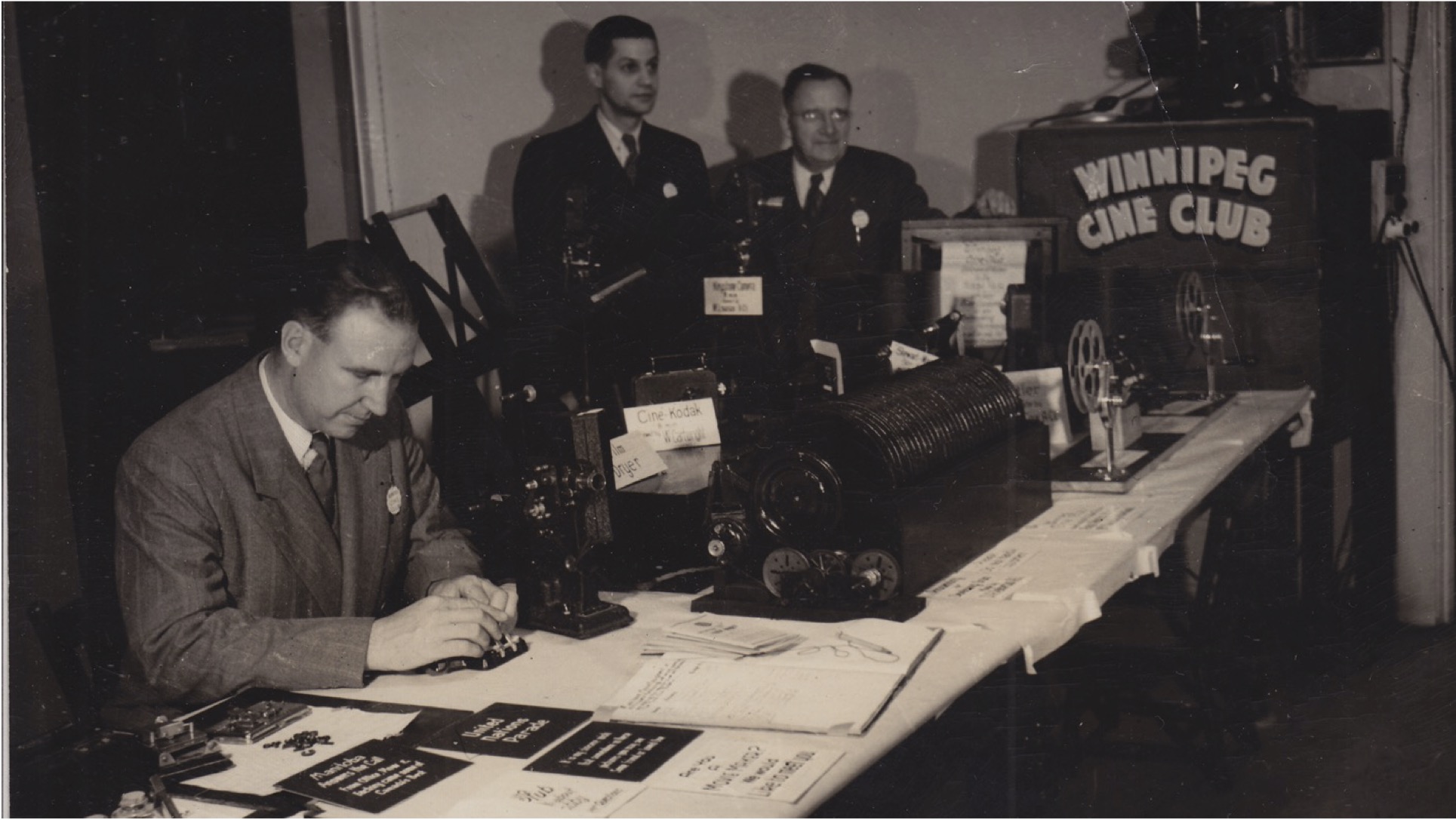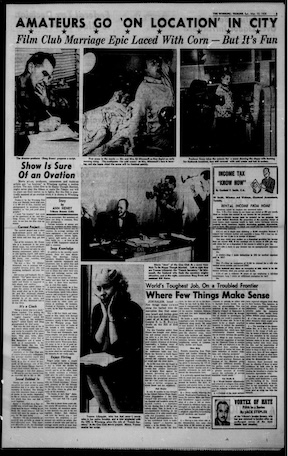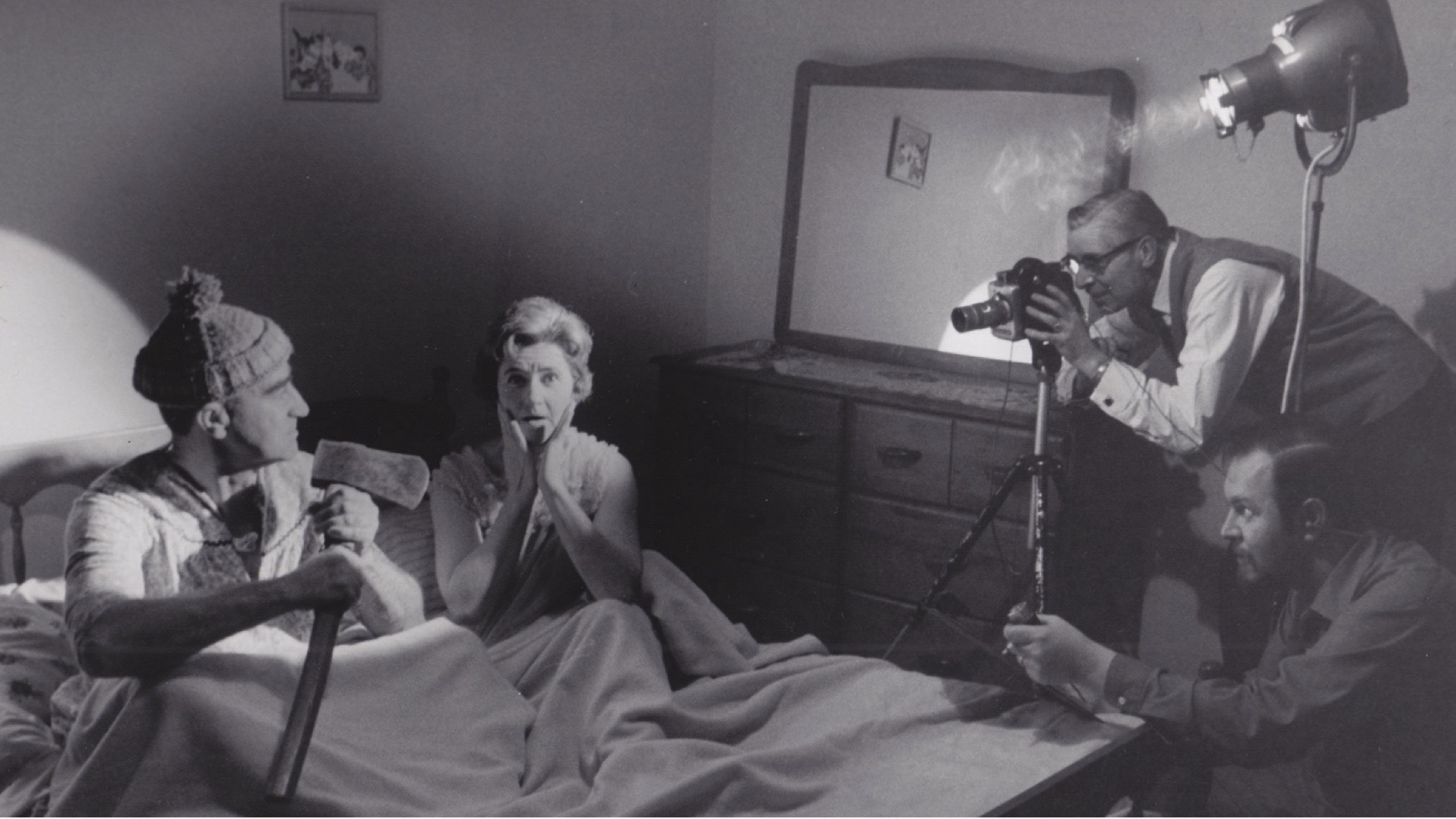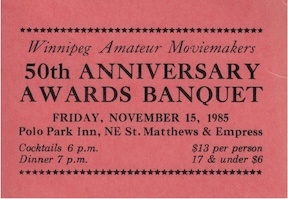by Kevin Nikkel

The Winnipeg Cine Club was born of a time when consumer friendly 8mm and 16mm cameras were just arriving in stores—those that got their hands on the gear were excited to meet friends who shared their passion. The group was officially founded in November 27, 1935 as the Winnipeg Cine Club by Ken Davey—an employee at the Hudson Bay Company store’s camera department—and Ken Mitchell—an employee of the Eastman Kodak Store.[1] The group began meeting to show each other’s films and to share ideas about filmmaking. The original name of the group was later changed to the Winnipeg Amateur Movie Makers in 1964, reflecting the group’s process of clarifying their identity. The club was affiliated with the Amateur Cinema League, with the Society of Canadian Cine Amateurs (SCCA), the Society of American Videographers and Cinematographers (SAVAC), and the CANUSA film circuit of amateur movie clubs across North America.
Some members transitioned from amateur to professional—Ken Davey would find his career as the official cinematographer for the Winnipeg Blue Bombers football club—but many would be content with the community and identity they discovered as fellow amateurs. Their position as amateurs should not suggest a lack of commitment, nor sincerity, or event talent. At its height the group had 125 members.
The Winnipeg Cine Club met on a monthly basis—the early meetings were held at the YMCA, then the Free Press Club Room, later at the National Film Board Offices on St James Street, and in the last season of the club at the Church of the Way in River Heights.

In the 1930s and 1940s there was regular coverage in the local papers announcing dates and times for member screenings open to the public. In 1940 the club held a fundraiser for the Lord Mayor’s Fund to assist with bomb victims in London during the Second World War.[2]
Annual club banquets were well attended. Special events included the screening of amateur films in competition for prizes. The national network of amateur movie clubs allowed for the sharing of prize-winning films between clubs and groups acted as film juries to judge the work of each other’s club. In later years the Winnipeg club sought out interaction with local film professionals, on one occasion inviting Winnipeg NFB producer Ches Yetman to act as judge for one of their film contests. This relationship could have also facilitated the group’s use of the NFB facilities on St James Street for their meetings in the 1980s.
The group put great emphasis on process and the education of members to learn the craft of filmmaking. Discussions at meetings would explore editing techniques, adding titles to films, and the potential of adding sound to films. They embodied a do-it-yourself spirit before DIY became the recognized concept it is today. Being amateur didn’t mean there wasn’t considerable effort given towards excellence—editors of the monthly newsletter admonished members to strive for better:
“How are we, as amateurs, going to start to produce good story films? Let me say that I don’t think we have much hope in the average movie clubs as they are presently constituted. In my opinion their set-up isn’t designed primarily to produce motion pictures of entertainment value, they just provide a place for members to view each other’s mediocre films. At best they are mutual admiration societies, The movie clubs have become staid models of conformity. In film making we need less conformity and more individualism. Abject conformity with its sole by-product pleasing—and the hail-fellow-well-met approach are a depressing drug to the truly creative. To please should never be an end in itself, notwithstanding that one of the greatest pleasures we can get from our endeavours is honest reward for an honest job well done. Sure, pleasure is the reward, but certainly not the goal! Let’s be honest. We in movie clubs don’t bring into our ranks people of indisputable artistic talent, nor do we encourage those whose opinions differ very much from our own. If we do attract such persons, we very soon stifle their artistic efforts by our own preconceived, watered-down standards, and, of course, we lose these talented individuals.”[3]

The club’s regular newsletter “Moviecraft News” offered updates on what films would be screened, and also offered calls to cinematic action by the club’s executive. In the newsletter there is an ongoing negotiation of the amateur’s identity with articles/editorials discussing the nature of amateur filmmaking—in particular defining themselves in relation to professional filmmakers:
“An amateur is by definition a film which is made for the love of it; a professional film is made for money, as part of the maker’s job. But, if anyone, whether his name be Alfred Hitchcock or John Doe, makes a film for the love of it, then that film is an amateur film. It is certainly true that the professional has vastly more experience than the average amateur, but it is equally true that the genuine amateur who has been making films for 20 years, who has read every book on the subject that he can lay hands on and has attended all the lecture courses available, this man will have infinitely more experience than the beginner who has just shot his first film.”[4]

For the annual film contests, when the group had sufficient membership, they divided up into teams to make short films together, awarding trophies inscribed for the winners. These competition films moved beyond travelogues and home movies to include simple scripted narrative scenarios. Examples include: “How to Make Good Movies” (nd), a 100ft scripted film of a middle aged man that heads to a camera store to buy a camera and proceeds to shoot a role of 8mm film and send it off to be developed. “TV or not TV?” (1956) shows a man considering to buy a television. At a store he is encouraged by a salesman to go check out the local CBC studio to see how television shows are made, the visit is proof enough for him to buy a television. The footage is a fascinating window into the early years of the local television studio, preserved by amateurs.
In the January 1940 Moviecraft Newsletter of the group there was a notice that the next meeting would show footage that had not yet been edited. It was suggested that: “Members will not be asked to criticize these films” [5]—the comment shows the club’s sensitivity to members work—not wanting to crush the spirit of an emerging amateur filmmaker. This was a club built on relationships, friendships, and community. Their regular meetings bolstered by food and drink (cocktail hours are mentioned in various invitations) created close ties that extended to vacations and special outings.

At one point the group chartered a plane together for an arial vantage point of Winnipeg and Southern Manitoba—the outing was documented on 16mm film and a 500ft film created called “Our Adventures with the Winnipeg Cine Club.

In later years the group held an annual picnic at Winnipeg beach that included an afternoon of improv filmmaking by groups of amateur filmmakers. The greater purpose of the gathering was community. In one newsletter the purpose of the club was distilled down to a noble focus: “The aim of a movie club can hardly hope to be such as to change the world or shake the very foundations of creativity. May I suggest that its aim might be better simply to find more and more ways of enjoying doing things together.”[6]
As the lifespan of the group clocked from one decade to the next, members came and went. New members were brought in to the group as the leadership passed on the torch. Despite the annual activities of the group, there was the inevitable decline. Wally Robertson, a longstanding member remarked, “at one time, the club had about a 125 people in it, and it was big, and a lot of people were really enthused, but then television came along and the club went whoosh, down, because, all of a sudden everyone stayed at home and watched television. So, the club dropped a lot of members at that period.”[7]
Tension is evident in the newsletters as the group struggled to maintain their numbers and creative spirit: “In the early days of the clubs there seemed to exist more of a spirit of adventure in respect to a thirst for knowledge about what could be done with a movie camera—now it would seem that the new thirst is for more “buttons” to push—“easier” ways to produce “mediocre” home movies.”[8] If television and new “easier” Super8 cameras would subtract from the membership the age of easy digital cameras, social media and on line video distribution platforms like YouTube were a far greater threat.There was an increasingly desperate tone in the later newsletters. Al Ross, one of the final resilient members of the group wrote in the newsletter in 2004, “I see the urgent need to bolster our numbers—unless we are able to come up with other options.”[9]

The group was hanging on when I was invited to present on my documentary filmmaking at their monthly group meeting in 2013. They were enthusiastic when I asked if they would let me create a documentary about the group, there was hope it could bring in new members. But the reality was that the group was in the sunset of its life. Despite the age of the now small numbers—there were 8-10 people attending at the time—there was still a keen interest to talk about filmmaking. I was happy to discuss various editing strategies for using Apple Final Cut Pro 7 with amateur filmmaker Al Ross.
[1] From an editorial by Derek Davy in the December issue of Photographic Society of America Journal republished in the Winnipeg Cine Club’s Moviecraft News (ND).
[2] “Cine Club Supports Lord Mayor’s Fund.” Winnipeg Tribune. Wednesday, Nov 27, 1940, p. 3.
[3] From an editorial by Derek Davy in the December issue of Photographic Society of America Journal republished in the Winnipeg Cine Club’s Moviecraft News (ND).
[4] Winnipeg Cine Club. Unnamed Editorial by Walter R Lawson. Moviecraft News, January 6, 1967.
[5] Winnipeg Cine Club. Unnamed Editorial. Moviecraft News, January 1940.
[6] Winnipeg Cine Club. Editorial, Moviecraft News, Jan 6, 1967.
[7] Adventures with the Movie Club, Directed by Kevin Nikkel, Five Door Films, 2014.
[8] Winnipeg Cine Club. Editorial, Moviecraft News, April 1,1966.
[9] Winnipeg Amateur Movie Makers. Newsletter. Al Ross October 4, 2004.
[10] It is difficult establish the exact date of the end of the club. The last Winnipeg Amateur Movie Makers Newsletterdistributed was labelled May 2014, Scene 78, Take 6. I had a phone call with one of the few remaining members Al Ross in January 2024 and he wasn’t sure the year the club finally closed.